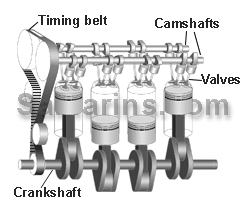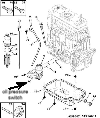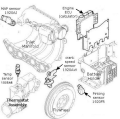
Peugeot 1.4 Engine
1360cc
Peugeot say that UK vehicles should do 20,000 miles between services; in fact it should be 20,000km and they simply didn't change the software for the UK. This can be corrected via PP2000 to get a true miles readout. Yes, I know it says a tiny "miles" on your screen; they changed that but not the 20,000 - so the countdown SHOULD have started at 12,500 or thereabouts. This is the reason for the ridiculous 40,000 miles expected of the spark plugs - and probably the cause of many failures to start or run properly. Changing plugs at 25,000 miles would have been far more realistic!
Also note that Peugeot number their cylinders unconventionally so that #1 is at the FLYWHEEL/CLUTCH/GEARBOX end, and #4 is at the cambelt/auxiliaries end.
see here for Lambda O2 sensors
see here for Auxiliary Belt and Cam Belt change
see here for Gearbox lubrication
Erratic starting and/or loss of power

Can be caused by the MAP sensor (Manifold Air Pressure) also known as the MAF (Mass Air Sensor) on the black plastic intake manifold just above the injectors with a clip on brown plug. The connector can also cause problems so check first before changing the sensor.

The MAP/MAF has a dual function as it measures both the airflow (heated wire) AND the temperature of the air (thermistor) entering the engine.
The remedy for intermittent operation is to carefully close (they break easily) and spray electrical cleaning fluid on the contacts. Plug back in and run the engine until hot or over 85°C - switch off and restart the engine four times. After the fourth time the engine light should clear.
Sudden loss of power - limp home mode:
Misfire due to worn plugs:
As a result of Peugeot having extended plug change intervals to 40,000 miles, the 1.6 engine had misfired big time at 32,000 miles and had to limp home. At almost 20,000 miles it was time to change the plugs on the 1.4 engine.

The plugs on the 8-valve engines are nearest the bulkhead and fiddly to access as they are well down in the block and access is limited.

First unclip (push the yellow part inwards to disengage) the breather hoses; then unclip most of the wiring and connectors on top of the engine.

Remove the small bracket holding the vacuum unit and then the two long studs holding the coil pack. Lift off the coil pack and manoeuvre it out; it should come fairly easily
Note that the connections to the plugs are sprung loaded; and press (not push on) the end of the plug.

To pull the plugs out, there is a tight-fitting insert inside the plug spanner - problem is - how to get it out in the restricted space?

Using a short locking ⅜" extension, it was possible to use a cranked pair of pliers to lever the spanner assembly up -

- *#2 cylinder is even more difficult as a stepper motor gets in the way. The plug spanner/short locking extension will just come out if angled and jiggled behind the stepper motor assembly.
*Cylinder 2 as counted starting from the clutch end on Peugeots.

Once removed, it was found that ALL plugs (Bosch Super FR7DE) were worn and gaps were around the 40thou mark (should be 30thou). I found the same on the yellow car - at 78,500 miles and if it had a service at 40,000 then plugs will have done 38,500 - all were out to 41thou.

The new plugs are NGK Iridium types BKR6EIX gapped to 30thou. These are supposed to last at least 50,000 miles so should see me and the car out!
NGK gives them a life expectancy of 40-50k miles. But they have to temper their projections as driving conditions and motor modifications differ. Typically we have found you can expect 60,000 to 80,000 miles on an unaltered motor.
And all clipped back together very easily - replace the wiring before the vacuum pipes . . . how do I know this?
Changing the Oil filter: (pictures from 1.6 engine)

This is a fairly straightforward task once you appreciate that you will need a large socket spanner to fit on the head of the filter canister.
Lift the bonnet; the filter is inside the black canister down low between the front panel and the engine just to the right of the exhaust manifold. Needs a large socket (27mm) to undo the top nut - then the cover comes off and the filter is inside; my filter came out with the cover. Clean the cover and fit a new sealing ring after oiling it.

Do fit a new oil seal onto the drain plug to avoid leaks.
Make sure the engine has the fresh oil in. It takes 3 litres of 5W/40 fully synthetic oil, never cheap oil. Or only 2.75 litres if the filter isn't changed at the same time.
I use Halfords 5W/40 fully synthetic myself - the Service Book says to use Total 5W/40 fully synthetic but I doubt there is any difference. I change mine (and the filter) about every 10,000 miles; I reckon 20,000 is too far to go even on synthetic.
Start the engine; don't rev until the light goes out (about two seconds). Stop the engine and recheck the level as some will have gone into the filter.
Check underneath for any drips - if none then job done!

In case the oil warning light comes on - after checking the oil level, the oil pressure sensor appears to be underneath the oil filter housing, facing forward - part no 1131C5
Changing the Air filter: (pictures from 1.6 engine)

This is a fairly straightforward task once you appreciate that the assembly comes out in one piece and then has to be taken apart to fit the filter.
- Ventilation pipe; push the yellow clip in to release and remove the pipe.
- Loosen the large circlip around the air outlet pipe to the inlet manifold.
- Air inlet - rotate the right angled connector to disconnect from the bottom of the air filter housing.
- Turn and release locking screw and jiggle air cleaner assembly out.

Remove 5 cross-point headed screws and replace filter.
The new air filter is much cleaner than the old one was - it had probably done 20,000 miles from new as Peugeot only expect to change them every 40,000 miles.
I have now fitted a direct fit K&N panel air filter eg ebay K&N air filter Peugeot 1007
Details of servicing K&N Filters here
Resetting the Service Indicator
hold in the tripmeter reset button and then turn ignition on and keep it holding in for at least 15 seconds
Valve Clearances
For the 8 valve 1007 Dolce: (which is the same engine as the 207 1.4)
Adjust the valve clearances:
Inlet clearance: 0.20 ± 0.05 (mm)
Exhaust clearance: 0.40 ± 0.05 (mm)
With exhaust valve fully open Inlet Exhaust
1 3 4
3 4 2
4 2 1
2 1 3
Tightening of the lock nuts:
Diameter M9 = 1.75 daNm
Diameter M6 = 0.9 daNm
I can't find any recommended intervals for adjustment
Anti-Freeze
I lost some of the water/antifreeze when I replaced the thermostat and replaced it by soft water from the tap. When I checked the (original) antifreeze was green in colour; the top-up I got from the Peugeot dealer was red so I didn't use it. When I checked I still had about 40% green antifreeze so should be OK for where I live in the UK.
However I found that Toyota uses a red antifreeze in many of its products and should not be confused with the orange type long life antifreezes. It is essentially the green type of antifreeze that contains red dye to give it the red colour. The Peugeot Stores operative confirmed this was correct and to top up with the red as supplied.




